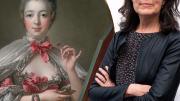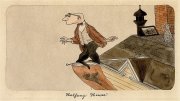Visiting a Victorian house museum with her mother (an architect), young Cassandra Albinson glimpsed a member of the staff open a small door under the stairs and disappear below. Her interest piqued, then fanned by an art-history course at Washington University in her native St. Louis, she pursued her studies at Wellesley and Yale. Now the Harvard Art Museums’ Winthrop curator of European art and head of the division of European and American art, she aims in turn to ignite the interest of young visitors. Her specialty is portraits of aristocratic women in nineteenth-century Britain and France. “Walking by one of these portraits, you might say, ‘Oh, that’s just a portrait of a beautiful woman,’” she says. But these powerful women “worked closely with artists” to present “their own images to society.” Take the museums’ portrait of Madame de Pompadour, which depicts Louis XV’s mistress as she applies makeup to her cheeks. Albinson notes its portrayal of motherhood, codification of race, and use of color. Pink, then new, occupied the space between the sensuality of red and the innocence of white: a fashionable way of signaling interest in new ideas circulating among the elite about women as intellectual beings with their own thoughts and desires—a kind of freedom. Not having access to the collection during the pandemic, she says, has been a shock. “There’s a real depth to these highly crafted and carefully thought-out objects”: the honing of the artists’ skills, the labor, the expensive materials, the time and the effort put into the paintings make them very complex. “They draw out a lot of attention in me that’s quite different than physical objects at home,” Albinson says. “I think it’s an emotional attachment.”
Harvard Portrait: Cassandra Albinson
Harvard Portrait: Cassandra Albinson
A curator takes a fresh look at portraits of aristocratic European women.

Cassandra Albinson
Photograph by Stu Rosner; Painting: Jeanne-Antoinette Poisson, Marquise de Pompadour (1750) by François Boucher/Courtesy of the Harvard Art Museums/Fogg Museum, Bequest of Charles E. Dunlap
You might also like
England’s First Sports Megastar
A collection of illustrations capture a boxer’s triumphant moment.
Rachel Ruysch’s Lush (Still) Life
Now on display at the Museum of Fine Arts, a Dutch painter’s art proved a treasure trove for scientists.
The Artist Edward Gorey—and Pets—at Harvard
Winter exhibits at Houghton Library
Most popular
Explore More From Current Issue

This TikTok Artist Combines Monsters and Mental Heath
Ava Jinying Salzman’s artwork helps people process difficult feelings.

The Trouble with Sidechat
No one feels responsible for what happens on Harvard’s anonymous social media app.






